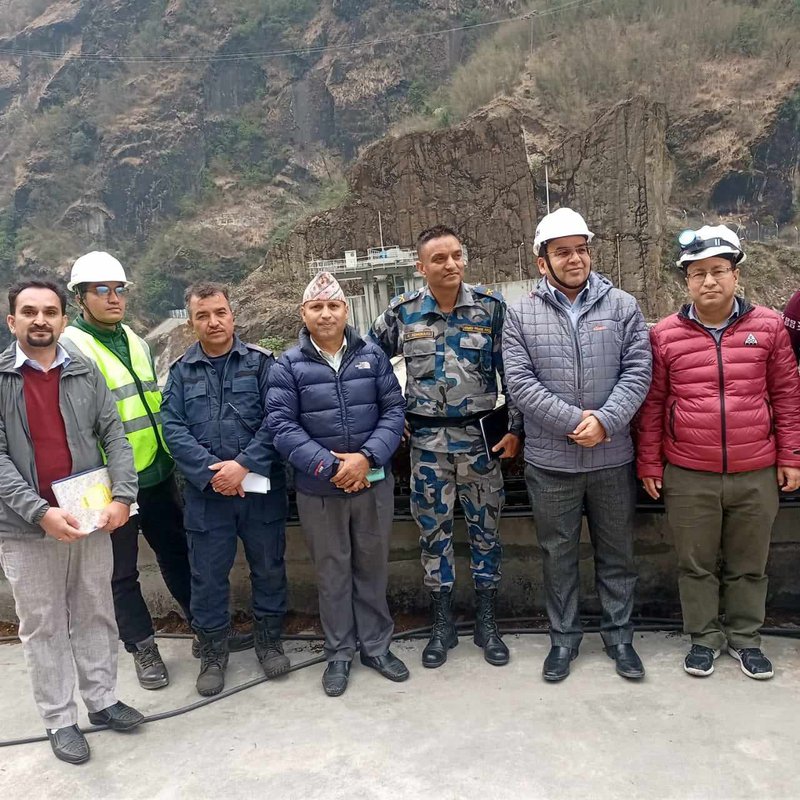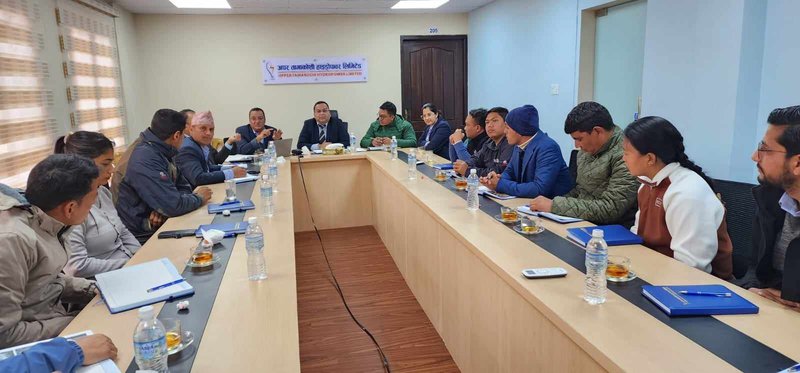

What is the current status of electricity generation?
Currently, electricity generation has been significantly impacted by the effects of climate change. At present, up to 300–456 MW of electricity can be generated during the evening and morning peak periods for 3-4 hours, as water is collected throughout the day. Due to changing climate patterns, the water level in the Tamakosi River has decreased, resulting in a decrease in electricity generation.
How do you see your one year tenure as Chief Executive Officer(CEO)?
When I assumed the role of CEO on Chaitra 14 (March 2023), the company resembled a project office, lacking the necessary institutional mechanisms and capacity to operate as a corporate entity. A significant portion of my time has been dedicated to establishing and institutionalizing the company. I have overseen the recruitment of new staff members to support the development of these new institutions. Sufficient technical manpower is recruited to run the plant efficiently and independently, whereas some administrative positions have also been filled as per the revised organizational chart of the company. Moreover, priority and efforts are made to conclude the construction contracts. I view my one-year tenure as a period of transformation and transition. Consequently, my first year has been dedicated to establishing and reforming the institution as a corporate entity

What are the challenges facing the CEO now?
I am still confronted with the challenges that have been passed down from the construction phase. Ever since I assumed the role of CEO, the water discharge has been decreasing due to global climate patterns, and the company is also being penalized for a situation that was not caused by any technical malfunction. To address this, I have initiated a public offering and distributed shares to the general public, and issued an IPO. Additionally, I have organized a general meeting for the company.
Considering that the data indicates your company is suffering from changing weather patterns, what steps are you taking to build a case for loss and damage claims?
We have gathered sufficient documentation and evidence to demonstrate the damage caused by changing weather patterns. We are currently compiling all necessary documents to support our claim for losses if the global community agrees to provide compensation. On a domestic level, we have already appealed to the Nepal Electricity Authority (NEA) to waive the penalties incurred due to the loss of energy caused by unavoidable circumstances. The current circumstances are beyond our control.
How NEA is responding to the crisis?
NEA has responded to the company's request by not making any efforts to reduce the penalty costs, as we are simply adhering to the clauses outlined in the Power Purchase Agreement (PPA). There is a specific clause regarding force majeure events. We have been advocating that drought should be classified as a force majeure event. Our company has been arguing that both droughts and heavy rainfall are natural occurrences and should be considered force majeure events to mitigate penalties. NEA has yet to agree to this point. This issue is not unique to our company, as other independent power producers (IPPs) and NEA's subsidiaries are also grappling with similar challenges.

How is the state of electricity generation?
I have already mentioned that the generation of electricity has been fluctuating since the inception of the generation three years ago. In the month of 2078 Chaitra (March-April), the company exceeded the contract energy by 35.89%, delivering 98,440,820 kWh. However, in the following months of 2079 Baisakh and Jestha (April-June), the generation declined. In Baisakh, the company delivered 103,230,460 kWh, which was 13.65% less than the contract energy of 119,547,000 kWh. In Jestha, the plant delivered 212,115,350 kWh, which was 24.42% less than the contract energy of 280,640,000 kWh.
How about the generation trend last year?
The decline in generation persisted, resulting in a shortfall in delivering the contracted energy. In the month of Chaitra 2079 (March-April 2023), the company fell short by 30.67 percent, leading to a penalty payment of Rs. 55,402,518.30 to NEA. Subsequently, in Baisakh and Jestha 2080 (April-May and May-June 2023), the company could deliver to NEA 54.38 percent and 50.18 percent less with respect to Contract Energy respectively. It is noteworthy that no penalties were paid in the years 2079–80. Over the span of three months, including Chaitra 2079, Baisakh, and Jestha 2080, the company incurred a total penalty of Rs. 538,360,209.75 to NEA. It raises the question of whether PPA conducted a thorough study and analysis of hydrology.

What was the average discharge of the river?
The discharge pattern of water in the Tamakoshi river during the months of Chaitra, Baisakh, and Jestha in the consecutive five years from 2072 to 2077 showed predominantly positive trends. The average discharge during this period was 32.0 cubic meters per second (cumecs), which was significantly higher compared to the average of the last three years, which ranged from 10.8 to 14.0 cumecs. This below-average water level had a detrimental impact on the generation of the project, resulting in a heavy loss of energy. Last year alone, our cumulative loss exceeded a billion. Given the weather conditions in the previous winter, characterized by prolonged winter drought and minimal snowfall, it is likely that this year's losses will further increase.
How would you describe the condition of the watershed?
It is important to note that the availability of water in the Tamakoshi River is currently at an average of 11 cubic meters per second in the month of March. The condition of the watershed, particularly in the upper Tamakoshi area, is concerning. Approximately 70 percent of the high Himalayan watershed area falls in Tibet, and this exacerbates the situation. This year, there has been a decrease in snowfall in the mountains, further impacting the water supply. As a result, all six units of the Upper Tamakoshi Hydropower Plant,each unit having a capacity of 76 MW, are unable to operate at full capacity due to the lack of water in the river.
Is there a provision in the Power Purchase Agreement (PPA) to exempt the company from penalties due to such natural occurrences?
The contract energy delivery was based on a meticulous examination of 15 years' water discharge data, with the agreed generation in the PPA being contingent on the river's discharge. According to the PPA terms, the company is obligated to pay a penalty if it fails to deliver 80 percent of the expected contract energy to the NEA. While there is a provision to waive the penalty in cases of "unavoidable circumstances," it must be proven that the situation falls under this category. NEA has not yet clarified the interpretation of this term.
Has any documentation been prepared in case Nepal becomes eligible to declare its support for the loss and damage agenda, as it has been advocating for along with other LDCs?
We possess sufficient recorded data that demonstrates a significant decrease in water discharge in the Upper Tamakoshi region over the past five years. The Department of Hydrology and Meteorology's data also indicates a change in discharge patterns, with a notable decline in water flow. The data collected over the past 15 years illustrates the fluctuating nature of river discharge, with a consistent decrease in water flow each year, particularly in the last three years.

What are the mitigation efforts the company is taking?
The company has taken several mitigation efforts to address the issues inherited from the construction period. One of the key efforts is the start of the construction of the RolwalingKhola Hydroelectric Project, which has an installed capacity of 22 MW. Apart from 105 GWh of annual energy generated from this power plant itself, an additional 212 GWh of annual energy, which is equivalent to 50–60 MW will be generated from the Upper Tamakoshi Hydropower Plant by the diversion of the Rolwaling Kalato Upper Tamakoshi Hydropower Plant (UTKHPP) Reserve at Lamabagar. This project will enhance the dry season energy of UTKHPP and peaking hours from 4 hours to 6 hours even in the driest months.
What about the status of Rolwaling?
Currently, after the mobilization at the project site, the contractor has already started the excavation of the diversion tunnel and the construction of other infrastructure for the RolwalingKhola Hydroelectric Project. Similarly, the construction of the main access tunnel to the powerhouse is also ongoing. However, the contractor is facing challenges in obtaining permission from India to import explosives, as the joint venture involves a Chinese contractor company. The company has applied for explosives through the Indian Embassy, but it is currently in a pending status.

How does the does the RolwalingKholaHydropower Project impact the Upper Tamakoshi Hydropower Plant?
Upon the completion of the Rolwaling River diversion, the energy output of the Upper Tamakoshi HPP will experience a significant improvement during the dry season. Once the diversion is in place, the company's power generation will increase by 212 GWh plus 105 GWh annually. This generation capacity is equivalent to that of a 60 MW project and will be available during the peak demand period. It is worth noting that the tariff for electricity during peak hours is higher than the standard rate. If the necessary explosives are provided as per demand, the construction of the diversion tunnel will be finished within three years.
What is the progress now?
The main tunnel for the diversion of water, measuring 250 meters in length, has been opened. Additionally, some 240 meters of Main Access Tunnel to the powerhouse have also been completed. Since there is no motorable access to the Headworks Site and nearby work fronts, the construction of Mule Track from Lower Lamabagar has been substantially completed, and further improvements for the track are underway. This will enhance the excavation of the diversion tunnel from other ends as well, which will help expedite the excavation progress of the diversion tunnel in order to complete the excavation of the tunnel in time.
The equipment necessary for the construction of works at Headworks and other work fronts of the project has to be airlifted. As soon as the necessary equipment is transported, excavation will begin from the other side as well.
Are you familiar with what constitutes loss and damage?
This topic has gained popularity in recent global climate discussions. Loss and damage can arise from extreme weather events such as droughts, glacial retreat, and land degradation. In essence, it involves claiming compensation for damages caused by the impacts of climate change. As a CEO, I am also trying to see how Upper Tamakoshi’s current crisis can become Nepal’s global agenda to get compensation for the loss.
What other steps are you taking?
By providing clean energy, we have been actively contributing to the reduction of emissions. Additionally, we are exploring the possibility of participating in carbon trading. To achieve this, we are in need of hiring a team of experts. This move will significantly enhance the financial well-being of the company. We are currently contemplating our next steps and are seeking guidance from professionals on how to proceed.

Given that the changing weather patterns have already led to a decrease in river water discharge, how do you anticipate the economic losses for the company?
The economic losses resulting from reduced water levels significantly impact the generation of clean electricity as an alternative to fossil fuels. The decreased generation and penalties for failing to meet energy delivery contracts are also affecting profits and constraining resources for expansion. Although the impact may seem minor, it has national-scale repercussions.

Keshab Poudel
Poudel is the editor of New Spotlight Magazine.
- KUL MAN GHISING: Bowing Down To The People
- Apr 13, 2025
- POLITICAL VIOLENCE: Culture of Impunity
- Apr 11, 2025
- PM OLI MEETS PM MODI: No Progress
- Apr 09, 2025
- PM OLI’S THAILAND VISIT: Flip Flop
- Apr 08, 2025
- FM Dr. Deuba’s India Visit: Mission Aborted
- Mar 26, 2025















